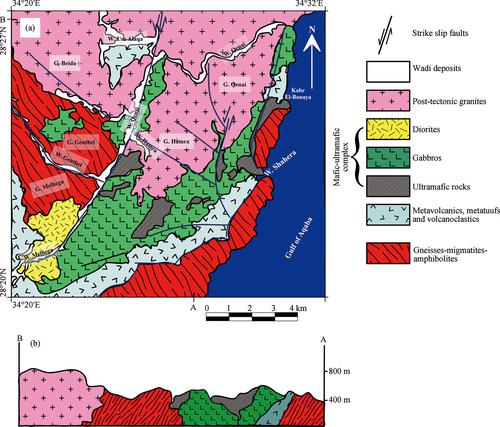当前位置:
X-MOL 学术
›
Acta Geol. Sinica Engl. Ed.
›
论文详情
Our official English website, www.x-mol.net, welcomes your
feedback! (Note: you will need to create a separate account there.)
Genesis and Tectonic Implications of the Kabr El-Bonaya Ultramafic Rocks, Sinai Peninsula, Egypt: Constraints from Mineralogical and Geochemical Characteristics
Acta Geologica Sinica-English Edition ( IF 3.5 ) Pub Date : 2020-02-06 , DOI: 10.1111/1755-6724.14406 Moustafa Mohammed MOGAHED 1
Acta Geologica Sinica-English Edition ( IF 3.5 ) Pub Date : 2020-02-06 , DOI: 10.1111/1755-6724.14406 Moustafa Mohammed MOGAHED 1
Affiliation

|
The Kabr El-Bonaya mafic–ultramafic intrusion is exposed along the southeastern border of the Sinai Peninsula and the northernmost segment of the Arabian-Nubian Shield (ANS). It occurs as an elliptical intrusive body that is located along the major NE–SW trending fracture zones that prevail in the Kid metamorphic complex. The ultramafic rocks in the complex comprise ultramafic cumulates of peridotites (dunite, harzburgite and wehrlite) and pyroxenite. These rocks are generally unmetamorphosed and have intrusive contacts with the country rock. Mineral chemistry and whole-rock chemical compositions of these ultramafic rocks are mostly consistent with those of residual mantle peridotites from refractory supra-subduction tectonic settings. Based on the variations of the major elements, the studied ultramafic rocks are consistent with those of a supra-subduction zone mantle, as it seems to have melted at 1–2 GPa and 1300–1450°C. Linear variations of Al2O3, CaO, V and Ni with MgO, coupled with incompatible and rare-earth-element depletion and mineral compositions, suggest prior events of partial melting in both wehrlites and harzburgites. The LREE enrichment in the harzburgite, as well as the development of Cr-rich spinel, is consistent with a history of melt–peridotite interaction. The calculated (Sm/Yb)N variations for the studied peridotites indicate a general increase in the addition of fluids with an increasing degree of melting from the wehrlite (∼13–15 wt% of fluid) in the source, after initial spinel peridotite melting to the harzburgite (∼20–25 wt% of fluid) in the same source, which is contrary to normal abyssal peridotites. The estimated equilibration temperature ranges from 1214 to 1321°C for the studied wehrlites and from 1297 to 1374°C for harzburgites. The Mg-rich nature of the analysed olivines from the studied ultramafic rocks (Fo = 81.41 to 91.77) reflect their primary composition and are similar to olivines in Alaskan-type ultramafic rocks. The Fo content of the analyzed olivines decrease slightly from the dunite to the harzburgite to the wehrlite and to pyroxenite, reflecting a fractional crystallization trend. The high Cr# and very low TiO2 contents (0.03–0.12 wt%) of the Cr-spinels from the studied peridotites are mostly consistent with modern highly refractory fore-arc peridotites, indicating that these peridotites developed in a supra-subduction zone environment.
中文翻译:

埃及西奈半岛Kabr El-Bonaya超基性岩的成因和构造意义:来自矿物学和地球化学特征的约束
Kabr El-Bonaya镁铁质-超音波侵入体沿西奈半岛的东南边界和阿拉伯-努比亚盾(ANS)的最北段暴露。它以椭圆形侵入体的形式出现,位于基德变质复合体中主要的NE-SW趋势断裂带上。复合体中的超镁铁质岩石包括橄榄岩的超镁铁质堆积物(钙云母,辉石和辉绿岩)和辉石岩。这些岩石通常是未变质的,并且与乡村岩石具有侵入性的接触。这些超镁铁质岩石的矿物化学和全岩石化学成分与耐火超俯冲构造环境中残留的地幔橄榄岩的矿物化学和整体岩石化学成分基本一致。根据主要元素的变化,所研究的超镁铁质岩石与超俯冲带地幔相一致,因为它似乎在1-2 GPa和1300-1450°C时融化了。Al的线性变化2 O 3,CaO,V和Ni与MgO结合,以及稀土元素的不相容和贫化以及矿物质成分,提示在辉绿岩和哈氏岩中均发生部分熔融的先前事件。钙铁矿中轻稀土的富集以及富铬尖晶石的发展与熔融橄榄岩的相互作用历史一致。计算得出的(Sm / Yb)N经研究的橄榄岩的变化表明,从最初的尖晶石橄榄岩熔融到哈茨伯格岩(〜20-25)后,随着源中白云母(约占流体的13-15%)的融化程度的增加,流体的添加量总体上增加了。流体的重量百分比),这与正常的深渊橄榄岩相反。对于研究的陨石,估计的平衡温度范围为1214至1321°C,而对于尖晶石,其平衡温度范围为1297至1374°C。所研究的超镁铁质岩石(Fo = 81.41至91.77)中所分析橄榄石的富镁性质反映了它们的主要成分,与阿拉斯加型超镁铁质岩石中的橄榄石相似。分析的橄榄石中的Fo含量从榴辉岩到辉石辉石到辉绿岩和辉石辉石略有下降,反映出部分结晶趋势。高铬#和研究的橄榄岩中Cr-尖晶石的TiO 2含量非常低(0.03-0.12 wt%)与现代高度耐火的前弧形橄榄岩基本一致,表明这些橄榄岩在超俯冲带环境中发育。
更新日期:2020-02-06
中文翻译:

埃及西奈半岛Kabr El-Bonaya超基性岩的成因和构造意义:来自矿物学和地球化学特征的约束
Kabr El-Bonaya镁铁质-超音波侵入体沿西奈半岛的东南边界和阿拉伯-努比亚盾(ANS)的最北段暴露。它以椭圆形侵入体的形式出现,位于基德变质复合体中主要的NE-SW趋势断裂带上。复合体中的超镁铁质岩石包括橄榄岩的超镁铁质堆积物(钙云母,辉石和辉绿岩)和辉石岩。这些岩石通常是未变质的,并且与乡村岩石具有侵入性的接触。这些超镁铁质岩石的矿物化学和全岩石化学成分与耐火超俯冲构造环境中残留的地幔橄榄岩的矿物化学和整体岩石化学成分基本一致。根据主要元素的变化,所研究的超镁铁质岩石与超俯冲带地幔相一致,因为它似乎在1-2 GPa和1300-1450°C时融化了。Al的线性变化2 O 3,CaO,V和Ni与MgO结合,以及稀土元素的不相容和贫化以及矿物质成分,提示在辉绿岩和哈氏岩中均发生部分熔融的先前事件。钙铁矿中轻稀土的富集以及富铬尖晶石的发展与熔融橄榄岩的相互作用历史一致。计算得出的(Sm / Yb)N经研究的橄榄岩的变化表明,从最初的尖晶石橄榄岩熔融到哈茨伯格岩(〜20-25)后,随着源中白云母(约占流体的13-15%)的融化程度的增加,流体的添加量总体上增加了。流体的重量百分比),这与正常的深渊橄榄岩相反。对于研究的陨石,估计的平衡温度范围为1214至1321°C,而对于尖晶石,其平衡温度范围为1297至1374°C。所研究的超镁铁质岩石(Fo = 81.41至91.77)中所分析橄榄石的富镁性质反映了它们的主要成分,与阿拉斯加型超镁铁质岩石中的橄榄石相似。分析的橄榄石中的Fo含量从榴辉岩到辉石辉石到辉绿岩和辉石辉石略有下降,反映出部分结晶趋势。高铬#和研究的橄榄岩中Cr-尖晶石的TiO 2含量非常低(0.03-0.12 wt%)与现代高度耐火的前弧形橄榄岩基本一致,表明这些橄榄岩在超俯冲带环境中发育。











































 京公网安备 11010802027423号
京公网安备 11010802027423号